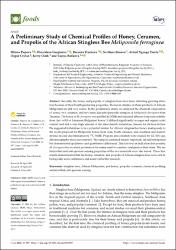A preliminary study of chemical profiles of honey, cerumen, and propolis of the african stingless bee meliponula ferruginea

Göster/
Tarih
2021Yazar
Popova, Milena PetkovaGerginova, Dessislava
Trusheva, Boryana S.
Simova, Svetlana D.
Tamfu, Alfred Ngenge
Ceylan, Özgür
Clark, Kerry
Bankova, Vassya Stefanova
Üst veri
Tüm öğe kaydını gösterKünye
Popova, M.; Gerginova, D.; Trusheva, B.; Simova, S.; Tamfu, A.N.; Ceylan, O.; Clark, K.; Bankova, V. A Preliminary Study of Chemical Profiles of Honey, Cerumen, and Propolis of the African Stingless Bee Meliponula ferruginea. Foods 2021, 10, 997. https://doi.org/10.3390/ foods10050997Özet
Recently, the honey and propolis of stingless bees have been attracting growing atten-tion because of their health-promoting properties. However, studies on these products of African Meliponini are still very scarce. In this preliminary study, we analyzed the chemical composition of honey, two cerumen, and two resin deposits (propolis) samples of Meliponula ferruginea from Tanzania. The honey of M. ferruginea was profiled by NMR and indicated different long-term stability from Apis mellifera European (Bulgarian) honey. It differed significantly in sugar and organic acids content and had a very high amount of the disaccharide trehalulose, known for its bioactivities. We suggested trehalulose to be a potential marker for African stingless bee honey analogously to the recent proposal for Meliponini honey from Asia, South America, and Australia and demonstrated its easy discrimination by13 C NMR. Propolis and cerumen were studied by GC-MS (gas chromatography-mass spectometry). The samples contained mainly terpenoids (di-and triterpenes) but demonstrated qualitative and quantitative differences. This fact was an indication that possibly M. ferruginea has no strict preferences for resins used to construct and protect their nests. The an-timicrobial and anti-quorum sensing properties of the two materials were also tested. These first results demonstrated that the honey, cerumen, and propolis of African stingless bees were rich in biologically active substances and deserved further research

















